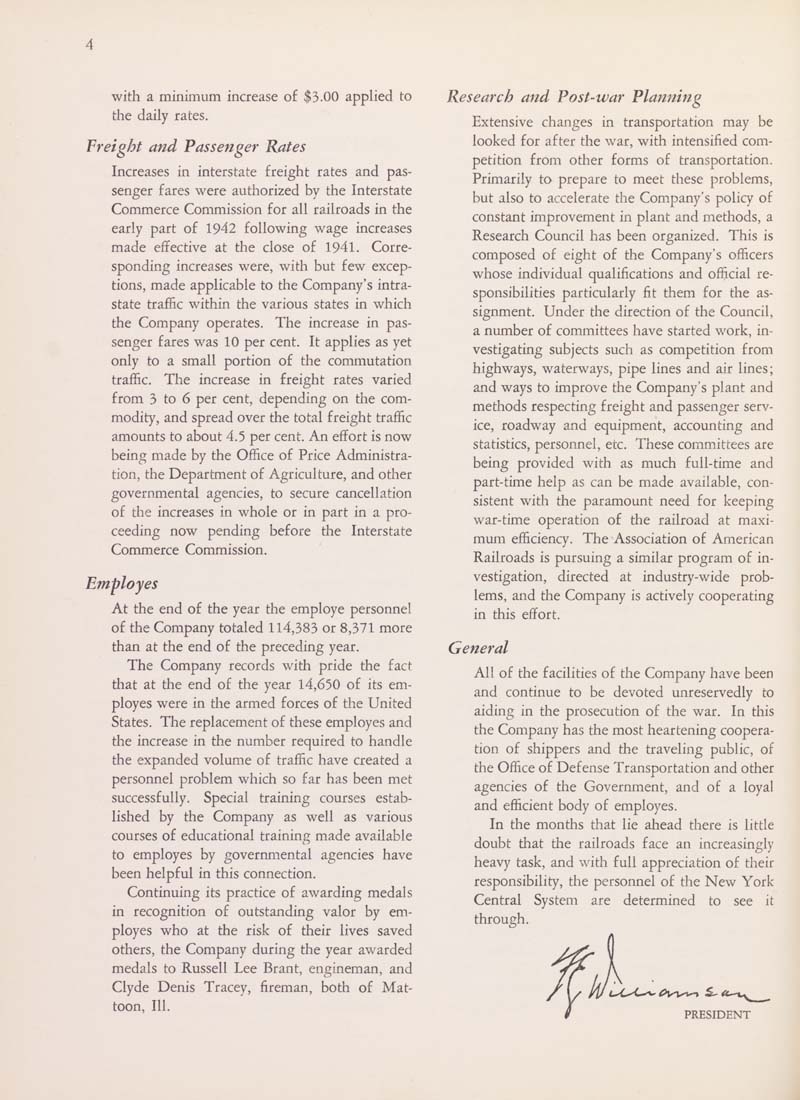with a minimum increase of $3.00 applied to
the daily rates.
Freight and Passenger Kates
Increases in interstate freight rates and pas¬
senger fares were authorized by the Interstate
Commerce Commission for all railroads in the
early part of 1942 following wage increases
made effective at the close of 1941. Corre¬
sponding increases were, with but few excep¬
tions, made applicable to the Company's intra¬
state traffic within the various states in which
the Company operates. The increase in pas¬
senger fares was 10 per cent. It applies as yet
only to a small portion of the commutation
traffic. The increase in freight rates varied
from 3 to 6 per cent, depending on the com¬
modity, and spread over the total freight traffic
amounts to about 4.5 per cent. An effort is now
being made by the Office of Price Administra¬
tion, the Department of Agriculture, and other
governmental agencies, to secure cancellation
of the increases in whole or in part in a pro¬
ceeding now pending before the Interstate
Commerce Commission.
Employes
At the end of the year the employe personnel
of the Company totaled 114,383 or 8,371 more
than at the end of the preceding year.
The Company records with pride the fact
that at the end of the year 14,650 of its em¬
ployes were in the armed forces of the United
States. The replacement of these employes and
the increase in the number required to handle
the expanded volume of traffic have created a
personnel problem which so far has been met
successfully. Special training courses estab¬
lished by the Company as well as various
courses of educational training made available
to employes by governmental agencies have
been helpful in this connection.
Continuing its practice of awarding medals
in recognition of outstanding valor by em¬
ployes who at the risk of their lives saved
others, the Company during the year awarded
medals to Russell Lee Brant, engineman, and
Clyde Denis Tracey, fireman, both of Mat-
toon, III.
Research and Post-war Planning
Extensive changes in transportation may be
looked for after the war, with intensified com¬
petition from other forms of transportation.
Primarily to prepare to meet these problems,
but also to accelerate the Company's policy of
constant improvement in plant and methods, a
Research Council has been organized. This is
composed of eight of the Company's officers
whose individual qualifications and official re¬
sponsibilities particularly fit them for the as¬
signment. Under the direction of the Council,
a number of committees have started work, in¬
vestigating subjects such as competition from
highways, waterways, pipe lines and air lines;
and ways to improve the Company's plant and
methods respecting freight and passenger serv¬
ice, roadway and equipment, accounting and
statistics, personnel, etc. These committees are
being provided with as much full-time and
part-time help as can be made available, con¬
sistent with the paramount need for keeping
war-time operation of the railroad at maxi¬
mum efficiency. The Association of American
Railroads is pursuing a similar program of in¬
vestigation, directed at industry-wide prob¬
lems, and the Company is actively cooperating
in this effort.
General
All of the facilities of the Company have been
and continue to be devoted unreservedly to
aiding in the prosecution of the war. In this
the Company has the most heartening coopera¬
tion of shippers and the traveling public, of
the Office of Defense Transportation and other
agencies of the Government, and of a loyal
and efficient body of employes.
In the months that lie ahead there is little
doubt diat the railroads face an increasingly
heavy task, and with full appreciation of their
responsibility, the personnel of the New York
Central System are determined to see it
through.
^V-t^w^ S" ^St—Vi
president
|








